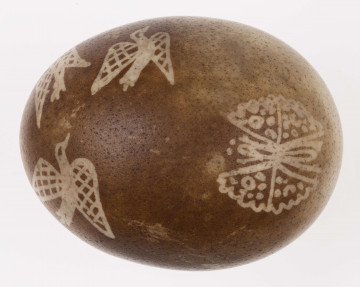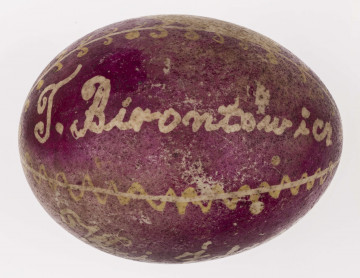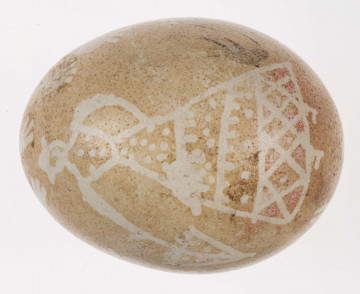
Easter egg
1901 — 1920
National Museum in Lublin
Part of the collection: Folk Art of the Lublin Region (17th–1st half of the 20th c.)
An Easter egg is an attribute of Easter, while an egg was a symbol of life, fertility, love and strength, and the symbolism of ornaments written on it played an important magical role. In the Lublin region, eggs were most often decorated using the batik technique, which involved writing on a pattern with melted wax using a marker made of sheet metal in the form of a funnel, set on a stick. In the past, natural vegetable dyes were used: onion skins, beetroot juice, oak, alder or apple bark, forkbeard seeds or young rye shoots, walnut bark, leaves and fruit peel, elderberry buds or fruit and poppy flowers.
According to the type of ornamentation, Lublin Easter eggs can be divided into two main groups: northern, where single-coloured patterns with straight lines predominate, and southern, with multicoloured and numerous volute ornaments (see E/1137/ML, E/1329/ML, E/1334/ML, E/1369/ML); in the central part of the Lublin region, influences intermingled and multicoloured ornaments with straight lines occurred.
"Pisanki" from the Puławy region were characterised by ornaments in the natural shade of the shell, yellow and sometimes blue, on a dark background obtained in onion decoction - usually brown, black and purple. The most popular motifs were linear bands sometimes crossing each other, ladders, Easter branches and rods, windmills similar to the shape of a swastika (see: E/1334/ML).
In the ethnographic collection of the National Museum in Lublin there are approximately 2500 Easter eggs made by artists from the Lublin region. Most were made in the years 1950-1980, but a significant proportion (around 500 pieces), unfortunately of unknown authorship, date from the early 20th century. This Easter egg is one of the oldest.
Author / creator
Dimensions
cały obiekt: height: 5,7 cm
Object type
Easter egg
Technique
batik
Material
wax, egg, plant-based pigment,
Creation time / dating
Creation / finding place
Owner
The National Museum in Lublin
Identification number
Location / status

1901 — 1920
National Museum in Lublin

1901 — 1920
National Museum in Lublin

1901 — 1920
National Museum in Lublin
DISCOVER this TOPIC
National Museum in Lublin
DISCOVER this PATH
Educational path